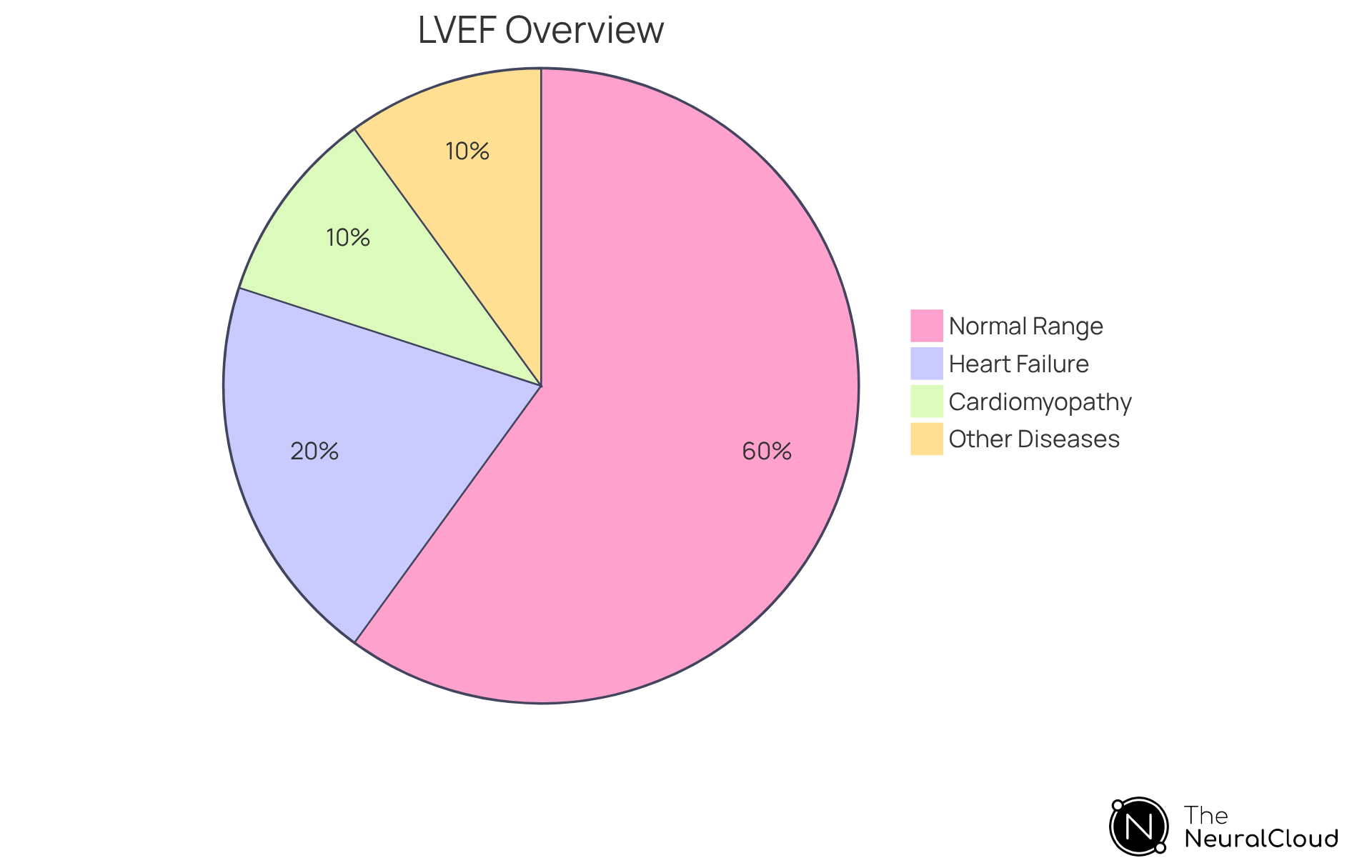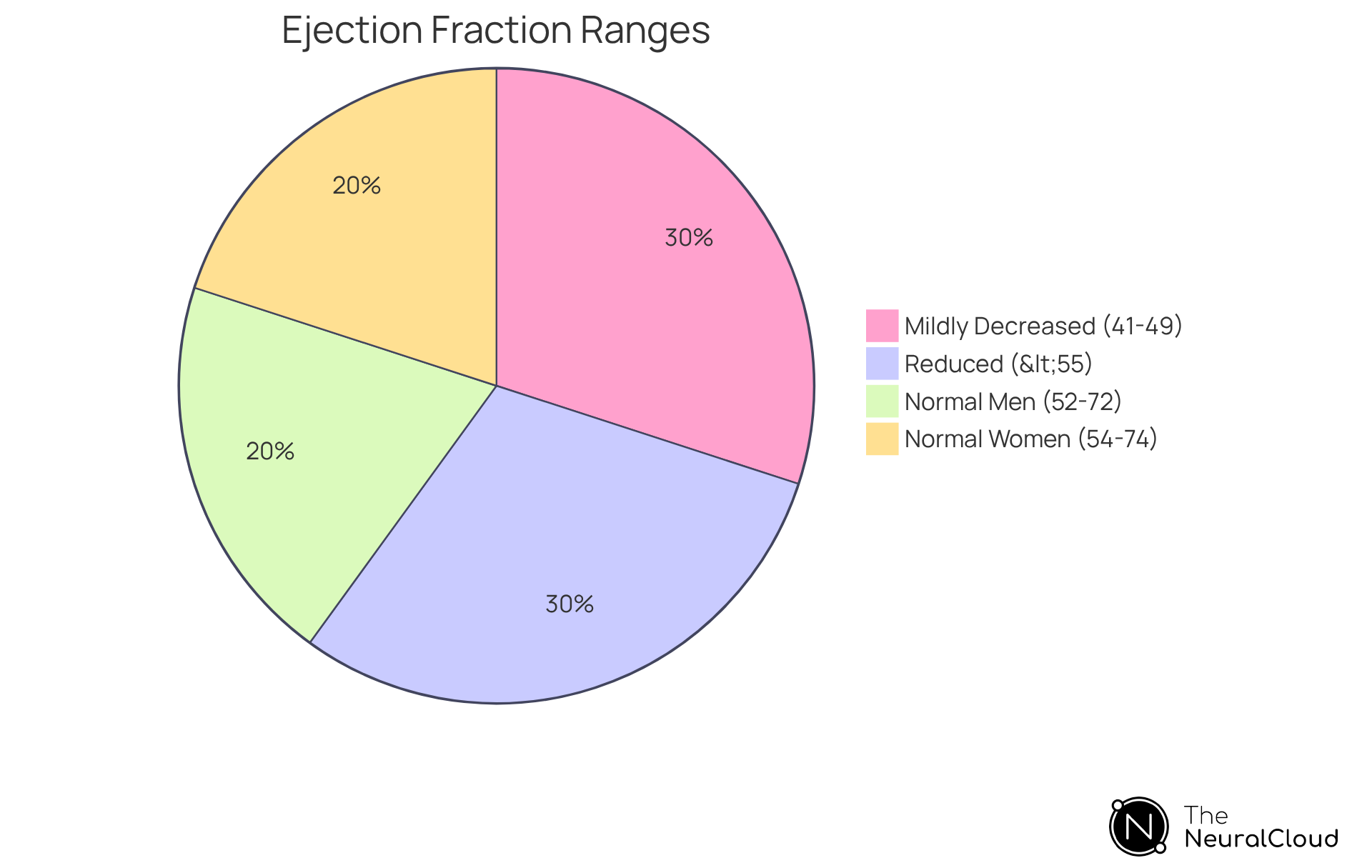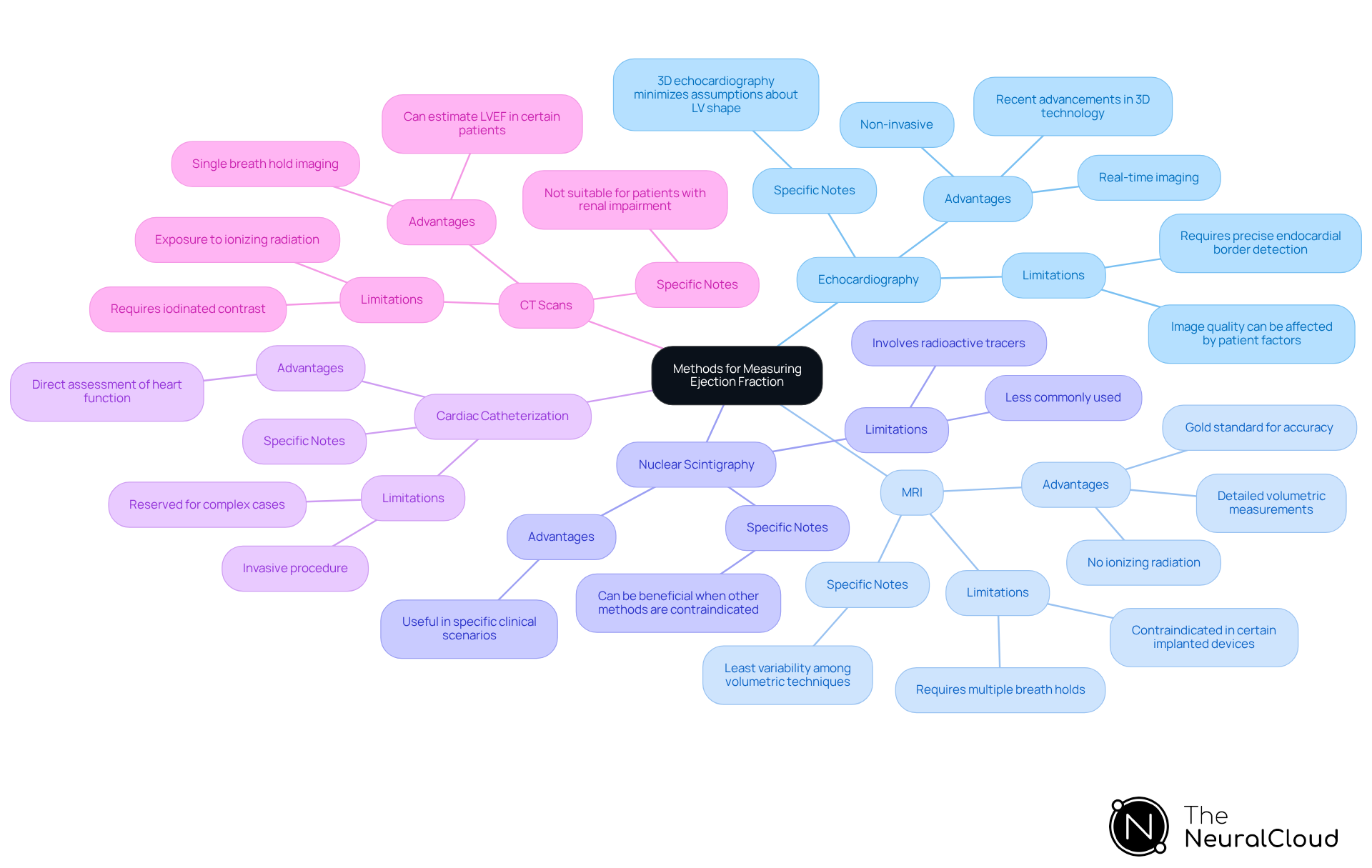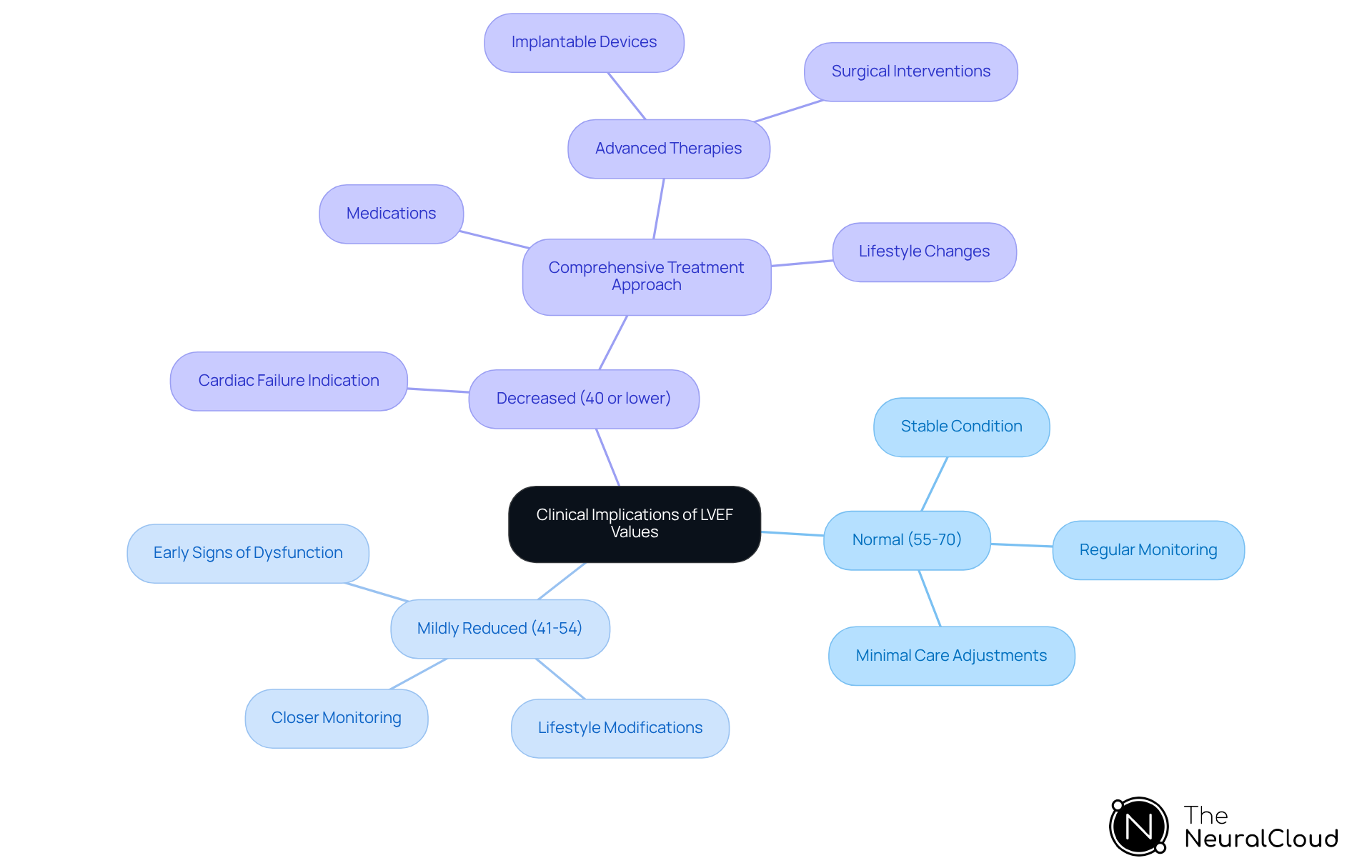Overview
The article provides an informative overview of normal left ventricular ejection fraction (LVEF), a critical measure for assessing heart function, with normal values defined as ranging from 55% to 70%. It highlights the significance of LVEF in diagnosing various cardiac conditions and in the customization of treatment strategies. The discussion is supported by an examination of measurement methods, clinical implications, and the variations in LVEF based on demographic factors.
Introduction
Understanding the intricacies of Left Ventricular Ejection Fraction (LVEF) is essential for anyone interested in heart health, as it serves as a key indicator of cardiac efficiency and function.
- Normal values typically range from 55% to 70%.
- Deviations from this range can signal underlying health issues, making it crucial for both diagnosis and treatment.
- Variations in LVEF across different demographics can significantly impact clinical assessments and patient outcomes.
This article delves into the significance of LVEF, exploring its normal ranges, measurement techniques, and the profound implications of its values on heart health management.
Define Left Ventricular Ejection Fraction and Its Importance
Left Ventricular Ejection Fraction (LVEF) is defined as the percentage of blood expelled from the left ventricle with each heartbeat. It serves as a vital indicator of the heart's efficiency and contractility. A normal left ventricular ejection fraction typically ranges from 55% to 70%, which indicates that the heart is functioning effectively.
Understanding LVEF is crucial for diagnosing various cardiac conditions, including:
- Heart failure
- Cardiomyopathy
- Other vascular diseases
Clinicians rely on this metric to assess the heart's pumping capability and to make informed treatment decisions. For instance, a significantly reduced LVEF may indicate heart failure, necessitating prompt medical intervention.

Explore Normal Ranges of Ejection Fraction
Standard values for normal left ventricular ejection fraction (LVEF) are typically recognized to be between 55% and 70%. However, recent studies indicate that these values can vary based on demographic factors such as age and sex.
For instance, the normal left ventricular ejection fraction for men is reported to be between 52% and 72%, while for women, it spans from 54% to 74%. Notably, a left ventricular ejection fraction between 41% and 49% is regarded as mildly decreased and may signal early heart problems. Additionally, figures below 55% may imply a mildly reduced ejection fraction, potentially indicating underlying cardiac concerns.
Studies have indicated that the lower threshold for normal left ventricular ejection fraction is 49.6% for males and 50.8% for females. This emphasizes the necessity for healthcare providers to take these differences into account when assessing an individual's heart health. Understanding these ranges is essential for healthcare professionals, as it aids in or intervention, ultimately impacting patient outcomes.

Detail Methods for Measuring Ejection Fraction
Measuring the normal left ventricular ejection fraction (LVEF) is crucial for assessing heart function, with several methods available, each presenting distinct advantages and limitations.
- Echocardiography is a non-invasive technique that utilizes ultrasound waves to create real-time images of the heart. This method is the most commonly employed for LVEF assessment. Recent advancements in 3D echocardiography have improved accuracy by minimizing assumptions about left ventricular (LV) cavity shape. As noted by Philip A Araoz from the Mayo Clinic, "With any method, the endocardial border must be precisely identified to ensure correct LV cavity detection and left ventricular ejection fraction calculation."
- [Cardiac Magnetic Resonance Imaging](https://theneuralcloud.com/post/10-key-artefact-ecg-issues-and-their-solutions) (MRI) is often regarded as the gold standard for LVEF measurement. It provides highly accurate and detailed images of cardiac structure and function, particularly excelling in volumetric measurements with slight variability. The standard range for normal left ventricular ejection fraction typically falls between 55% and 70%, with values below 40% indicating potential cardiac failure. This precision makes MRI a favored option for accurate calculations of normal left ventricular ejection fraction.
- Nuclear Scintigraphy involves the injection of a radioactive tracer, followed by imaging with a gamma camera to assess cardiac performance. Although less commonly used, this method can be beneficial in specific clinical scenarios, particularly when other imaging modalities are contraindicated.
- Cardiac Catheterization, an invasive procedure, directly assesses heart function, which includes evaluating the normal left ventricular ejection fraction, and is typically reserved for complex cases requiring detailed hemodynamic information.
- Computed Tomography (CT) scans can estimate LVEF, particularly in patients with contraindications to other imaging techniques. However, it is important to note that CT involves exposure to ionizing radiation and may require iodinated contrast, which should be used cautiously in individuals with renal impairment.
The choice of technique often hinges on the clinical context, individual characteristics, and available resources. For instance, echocardiography is preferred for its non-invasive nature and real-time capabilities, while MRI is chosen for its superior accuracy.
Understanding the strengths and limitations of each method is essential for clinicians to make informed decisions regarding patient care. Variability in LVEF calculations can arise from different processing systems, underscoring the importance of consistency in measurement techniques.

Analyze Clinical Implications of Ejection Fraction Values
The clinical implications of Left Ventricular Ejection Fraction (LVEF) values are profound, as they directly influence diagnosis, treatment choices, and patient outlook.
The interval of normal left ventricular ejection fraction (55%-70%) signifies healthy cardiac function, allowing for regular monitoring without the need for urgent intervention. Patients typically maintain a stable condition, requiring minimal adjustments to their care plans.
- Mildly Reduced Ejection Fraction (41%-54%): Values in this range may indicate early signs of cardiac dysfunction. Patients might benefit from lifestyle modifications and closer monitoring to prevent progression to more severe conditions.
- Decreased ejection fraction (40% or lower): This frequently suggests cardiac failure or significant myocardial dysfunction. Patients in this category may require a comprehensive treatment approach, including medications, lifestyle changes, and potentially advanced therapies such as implantable devices or surgical interventions.
Comprehending normal left ventricular ejection fraction values allows healthcare professionals to categorize risk, customize treatment strategies, and forecast results effectively. For instance, a decreasing left ventricular ejection fraction over time can indicate worsening heart failure, prompting timely interventions that can greatly enhance patient outcomes. Furthermore, left ventricular ejection fraction is essential in assessing eligibility for clinical trials and advanced treatments, highlighting its significance in both clinical practice and research.
Recent guidelines emphasize the necessity for a dynamic, trajectory-based method for assessing left ventricular ejection fraction, progressing beyond static classifications. This shift enables a more nuanced comprehension of and treatment response, ultimately improving patient care and outcomes. Approximately 6.7 million adults in the U.S. suffer from heart failure, with about 55% having a left ventricular ejection fraction of 40% or higher, underscoring the critical role of this measure in clinical practice. Furthermore, therapies like SGLT2 inhibitors have shown robust outcomes across the full range of LVEF, reinforcing the importance of comprehensive treatment strategies.

Conclusion
Understanding Left Ventricular Ejection Fraction (LVEF) is essential for evaluating heart health and diagnosing various cardiac conditions. This crucial metric reflects the percentage of blood pumped from the left ventricle during each heartbeat, with normal values typically ranging from 55% to 70%. Recognizing these values and their implications can significantly impact patient care and treatment strategies.
Throughout the article, key insights into the normal ranges of LVEF, the methods for measuring it, and the clinical implications of different ejection fraction values have been discussed. Variations in normal ranges based on demographic factors, such as age and sex, highlight the need for personalized assessments. The article also emphasizes the importance of using accurate measurement techniques, such as echocardiography and MRI, to ensure reliable evaluations of heart function.
Ultimately, understanding normal left ventricular ejection fraction is vital not only for diagnosing heart conditions but also for tailoring effective treatment plans. As heart disease continues to affect millions, a comprehensive grasp of LVEF can lead to improved outcomes and enhanced patient care. By prioritizing the assessment of ejection fraction in clinical practice, healthcare professionals can better navigate the complexities of cardiac health and contribute to more effective management of heart disease.
Frequently Asked Questions
What is Left Ventricular Ejection Fraction (LVEF)?
Left Ventricular Ejection Fraction (LVEF) is the percentage of blood expelled from the left ventricle with each heartbeat, serving as an indicator of the heart's efficiency and contractility.
What is the normal range for LVEF?
A normal left ventricular ejection fraction typically ranges from 55% to 70%, indicating that the heart is functioning effectively.
Why is understanding LVEF important?
Understanding LVEF is crucial for diagnosing various cardiac conditions, including heart failure, cardiomyopathy, and other vascular diseases.
How do clinicians use LVEF in medical assessments?
Clinicians rely on LVEF to assess the heart's pumping capability and to make informed treatment decisions. A significantly reduced LVEF may indicate heart failure, which requires prompt medical intervention.






